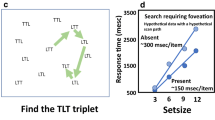Abstract
Visual attention is one of the key mechanisms of perception that enables humans to efficiently select the visual data of most potential interest. Machines face similar challenges as humans: they have to deal with a large amount of input data and have to select the most promising parts. In this chapter, we explain the underlying biological and psychophysical grounding of visual attention, show how these mechanisms can be implemented computationally, and discuss why and under what conditions machines, especially robots, profit from such a concept.
Access this chapter
Tax calculation will be finalised at checkout
Purchases are for personal use only
Similar content being viewed by others
Notes
- 1.
- 2.
Parts of this chapter have been published before in [5].
- 3.
The notation V1 to V5 comes from the former belief that the visual processing would be serial.
- 4.
In this chapter, we assume that the reader has basic knowledge on image processing, otherwise you find a short explanation of the basic concepts in the appendix of [5].
- 5.
- 6.
The number of levels that is reasonable depends on the image size, as well as on the size of the objects you want to detect. Larger images and a wide variety of possible object sizes require deeper pyramids. The presented approach usually works well for images of up to 400 pixels in width and height in which the objects are comparatively small as in the example images of this chapter.
- 7.
Since the input is a static image, the motion channel is empty and omitted here.
- 8.
Entries with value 1 are ignored since they indicate that the mean saliency of the target region is exactly the same as the mean saliency of the surrounding; such a feature is completely useless for detecting the target. However, in practice this usually does not occur unless a feature is not present at all, e.g., color is not present in a gray-scale image and the color weights are set to 1.
- 9.
Note that in human perception, bottom-up cues always play a role and thus should be considered if similarity to human perception is desired.
- 10.
References
Bruce, N.D.B., Tsotsos, J.K.: Saliency, attention, and visual search: An information theoretic approach. J. Vis. 9(3), 1–24 (2009)
Bundesen, C., Habekost, T.: Attention. In: Lamberts, K., Goldstone, R. (eds.) Handbook of Cognition. Sage, London (2005)
Douma, M.: Color Vision and Art. Retrieved Nov 2010 from http://webexhibits.org/colorart/ganglion.html (2008)
Elazary, L., Itti, L.: Interesting objects are visually salient. J. Vis. 8(3), 3 (2008)
Frintrop, S.: VOCUS: A Visual Attention System for Object Detection and Goal-Directed Search. Lecture Notes in Artificial Intelligence (LNAI), vol. 3899. Springer, Berlin/Heidelberg (2006)
Frintrop, S., Jensfelt, P.: Attentional landmarks and active gaze control for visual SLAM. IEEE Trans. Robot. 24(5) (2008). Special Issue on Visual SLAM
Frintrop, S., Rome, E., Christensen, H.I.: Computational visual attention systems and their cognitive foundations: A survey. ACM Trans. Appl. Percept. 7(1) (2010)
Gao, D., Han, S., Vasconcelos, N.: Discriminant saliency, the detection of suspicious coincidences, and applications to visual recognition. IEEE Trans. Pattern Anal. Mach. Intell. 31(6) (2009)
Itti, L., Baldi, P.: Bayesian surprise attracts human attention. Vis. Res. 49(10), 1295–1306 (2009)
Itti, L., Koch, C.: Feature combination strategies for saliency-based visual attention systems. J. Electron. Imaging 10(1), 161–169 (2001)
Itti, L., Koch, C., Niebur, E.: A model of saliency-based visual attention for rapid scene analysis. IEEE Trans. Pattern Anal. Mach. Intell. 20(11), 1254–1259 (1998)
James, W.: The Principles of Psychology. Dover, New York (1890)
Kandel, E.R., Schwartz, J.H., Jessell, T.M.: Essentials of Neural Science and Behavior. McGraw-Hill/Appleton & Lange, New York (1996)
Koch, C., Ullman, S.: Shifts in selective visual attention: towards the underlying neural circuitry. Hum. Neurobiol. 4(4), 219–227 (1985)
Liu, T., Zejian, Y., Sun, J., Wang, J., Zheng, N., Tang, X., Shum, H.-Y.: Learning to detect a salient object. IEEE Trans. Pattern Anal. Mach. Intell. 33(2), 353–367 (2009)
Palmer, S.E.: Vision Science: Photons to Phenomenology. MIT Press, Cambridge (1999)
Pashler, H.: The Psychology of Attention. MIT Press, Cambridge (1997)
Rotenstein, A., Andreopoulos, A., Fazl, E., Jacob, D., Robinson, M., Shubina, K., Zhu, Y., Tsotsos, J.K.: Towards the dream of intelligent, visually-guided wheelchairs. In: Proc. 2nd Int’l Conf. on Technology and Aging, Toronto, Canada, June 2007
Torralba, A., Oliva, A., Castelhano, M., Henderson, J.: Contextual guidance of eye movements and attention in real-world scenes: The role of global features on object search. Psychol. Rev. 113(4) (2006)
Treisman, A.: Preattentive processing in vision. Comput. Vis. Graph. Image Process. 31, 156–177 (1985)
Treisman, A.M., Gelade, G.: A feature integration theory of attention. Cogn. Psychol. 12, 97–136 (1980)
Treisman, A.M., Gormican, S.: Feature analysis in early vision: Evidence from search asymmetries. Psychol. Rev. 95(1), 15–48 (1988)
Tsotsos, J.K.: A ‘complexity level’ analysis of vision. In: Proc. of International Conference on Computer Vision: Human and Machine Vision Workshop, London, England, June 1987
Tsotsos, J.K.: A Computational Perspective on Visual Attention. MIT Press, Cambridge (2011)
Viola, P., Jones, M.J.: Robust real-time face detection. Int. J. Comput. Vis. 57(2), 137–154 (2004)
Walther, D., Koch, C.: Modeling attention to salient proto-objects. Neural Networks (2006)
Wolfe, J.M.: Guided search 2.0: A revised model of visual search. Psychon. Bull. Rev. 1(2), 202–238 (1994)
Wolfe, J.M.: Visual search. In: Pashler, H. (ed.) Attention, pp. 13–74. Psychology Press, Hove (1998)
Wolfe, J.M., Horowitz, T.S.: What attributes guide the deployment of visual attention and how do they do it? Nat. Rev., Neurosci. 5, 1–7 (2004)
Zach, C., Pock, T., Bischof, H.: A duality based approach for realtime TV−L 1 optical flow. In: Proc. of the Annual Meeting of the German Assoc. for Pattern Recognition (DAGM) (2007)
Author information
Authors and Affiliations
Corresponding author
Editor information
Editors and Affiliations
Rights and permissions
Copyright information
© 2011 Springer-Verlag London Limited
About this chapter
Cite this chapter
Frintrop, S. (2011). Computational Visual Attention. In: Salah, A., Gevers, T. (eds) Computer Analysis of Human Behavior. Springer, London. https://doi.org/10.1007/978-0-85729-994-9_4
Download citation
DOI: https://doi.org/10.1007/978-0-85729-994-9_4
Publisher Name: Springer, London
Print ISBN: 978-0-85729-993-2
Online ISBN: 978-0-85729-994-9
eBook Packages: Computer ScienceComputer Science (R0)




